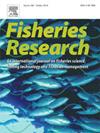Re-assessing the growth parameters for the razor clam, Ensis siliqua, from Scottish electrofishing grounds using external shell marks and oxygen isotope validation
IF 2.2
2区 农林科学
Q2 FISHERIES
引用次数: 0
Abstract
Landings of razor clams by global capture fisheries have increased by around 15 times since the turn of the century. Harvesting techniques range from hand-picking and use of brine solutions to force the clams to emerge, to more intensive mechanical and hydraulic dredging. In Scotland, electrofishing for the pod razor (Ensis siliqua) is presently the focus of a government run scientific trial. Growth estimates are an important component of fisheries management contributing to yield-per-recruit and natural mortality estimation. However, growth rate estimates should be periodically re-evaluated, particularly when harvesting practices have changed. Interpretation of external shell growth increments alongside validation by oxygen isotope analyses was used to generate length-at-age data for E. siliqua collected from five sites within the Scottish electrofishing scientific trial. Von Bertalanffy growth curves were then fitted to these data using a hierarchical Bayesian approach. Across all five sites the mean of the asymptotic length (L∞) was estimated to be 191 mm and the mean of the Brody coefficient (k) estimated at 0.27 y−1. The 95 % credible intervals for L∞ were from 182 to 206 mm, and for k were between 0.17 and 0.33 y−1. These new estimates are consistent with previous published results from Scottish sites suggesting that recent changes to harvesting practices have not led to substantial changes in E. siliqua growth rates.
利用外部贝壳标记和氧同位素验证重新评估苏格兰电鱼场的蛏子生长参数
自世纪之交以来,全球捕捞渔业捕捞的剃刀蛤数量增加了约15倍。收获技术包括手工采摘和使用盐水溶液迫使蛤蜊出现,以及更密集的机械和液压疏浚。在苏格兰,电捕豆荚剃刀(Ensis siliqua)目前是政府开展的一项科学试验的重点。增长估计是渔业管理的一个重要组成部分,有助于估计每捕捞产量和自然死亡率。但是,应定期重新评估增长率估计,特别是在收获方法发生变化时。在苏格兰电钓科学试验中,利用外部壳生长增量的解释和氧同位素分析的验证,生成了从五个地点收集的e.s iliqua的长度-年龄数据。Von Bertalanffy增长曲线然后使用层次贝叶斯方法拟合这些数据。在所有五个站点中,渐近长度(L∞)的平均值估计为191 mm, Brody系数(k)的平均值估计为0.27 y−1。L∞的95 %可信区间为182 ~ 206 mm, k的95 %可信区间为0.17 ~ 0.33 y−1。这些新的估计与之前发表的苏格兰站点的结果一致,这些结果表明,最近收获方法的变化并没有导致E. sililqua生长速度的实质性变化。
本文章由计算机程序翻译,如有差异,请以英文原文为准。
求助全文
约1分钟内获得全文
求助全文
来源期刊

Fisheries Research
农林科学-渔业
CiteScore
4.50
自引率
16.70%
发文量
294
审稿时长
15 weeks
期刊介绍:
This journal provides an international forum for the publication of papers in the areas of fisheries science, fishing technology, fisheries management and relevant socio-economics. The scope covers fisheries in salt, brackish and freshwater systems, and all aspects of associated ecology, environmental aspects of fisheries, and economics. Both theoretical and practical papers are acceptable, including laboratory and field experimental studies relevant to fisheries. Papers on the conservation of exploitable living resources are welcome. Review and Viewpoint articles are also published. As the specified areas inevitably impinge on and interrelate with each other, the approach of the journal is multidisciplinary, and authors are encouraged to emphasise the relevance of their own work to that of other disciplines. The journal is intended for fisheries scientists, biological oceanographers, gear technologists, economists, managers, administrators, policy makers and legislators.
 求助内容:
求助内容: 应助结果提醒方式:
应助结果提醒方式:


